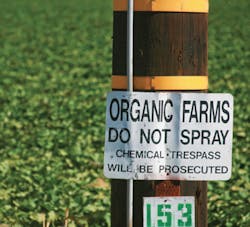How Product Liability Litigation Can Help Offset Expenses
By Alexander Leff
The California State Water Resources Control Board recently adopted regulations limiting the amount of 1,2,3 trichloropropane (TCP) in drinking water, affecting almost 100 communities in the state. The Board’s regulations set the maximum contaminant level (MCL) for TCP at 5 parts per trillion (ppt) in recognition of the toxic effects of the synthetic chemical. As a result, community water systems and non-transient/non-community water systems with elevated levels of TCP exceeding the MCL will have to spend large sums of money to treat and mitigate water contamination.
Livingston, Calif., a town of 13,000 people, produces 90 percent of the sweet potatoes grown west of the Rockies. Livingston is also home to decades of drinking water pollution that has exposed residents to elevated levels of TCP contamination.
Background
TCP got into groundwater primarily through the use of agricultural pesticides that contained TCP as an impurity. These pesticides were used extensively by California farmers, who were unaware of TCP, from the late 1940s through the 1980s to control nematodes — microscopic worms that harm plant roots and reduce plant growth. The pesticides were injected into the ground where they transformed into a gas that spread outward and downward, fumigating the soil to kill the nematodes. The pesticides contained TCP as an inactive ingredient.
One of the manufacturers ceased making its fumigant in 1984 and sold off its agricultural chemicals business, while the other reformulated its fumigant to remove most of the TCP. But, decades later, TCP remains in California groundwater supplies where a huge agricultural industry means that fumigant use, and thus TCP contamination, is particularly high.
One Town’s Story
Livingston, a town of 13,000 people, produces 90 percent of the sweet potatoes grown west of the Rockies. As the “sweet potato capital of California,” Livingston is also home to decades of drinking water pollution that has exposed residents to elevated levels of TCP contamination as a result of fumigant use on the town’s fields and orchards.
In 2005, California set a non-mandatory “public health goal” for TCP of 0.7 ppt; however, as early as 2004, the state told Livingston it had to test its wells for TCP. Livingston has eight active groundwater wells, ranging in capacities from 970 to 1,400 gallons per minute. The well with the lowest average concentration of TCP contained an average of 21 ppt, while the well with the highest had an average concentration of 770 ppt — more than 1,000 times what the state had deemed safe.
Based on the test results, the state recommended Livingston remove three of its groundwater wells from service. Without those wells, however, the city wouldn’t be able to meet the water needs of its residents. In order to keep the wells in service, the TCP would have to be removed from the water. The trouble was, Livingston couldn’t afford to pay for the treatment facility needed to remove the TCP. And it didn’t seem fair to increase rates and pass the costs on to ratepayers.
Livingston wasn’t the only community facing this challenge. Hawaii was the first state to discover the problem and set a legal limit for the amount of TCP in drinking water. In 2001 the TCP limit in Hawaii was 600 ppt. In 2004, the Hawaii Water Service Co., which services the Kaanapali area, filed suit against the two manufacturers, fumigant distributors, and the pineapple-turned-real estate giant Maui Land & Pineapple Co. to get those companies to pay for the treatment to remove the TCP from its drinking water. They settled before the case went to trial.
The Maui-based water utility was represented in the case by SL Environmental Law Group (SL), a San Francisco-based firm serving public sector clients in environmental contamination litigation. The firm agreed to help the city of Livingston recover costs of removing TCP from its groundwater, including the costs for engineering, environmental impact assessments, public contract and bidding, installation of the treatment facility, land acquisition, if necessary, and more.
SL and Livingston entered into a contingency fee agreement under which Livingston incurred no out-of-pocket costs. Instead, if and only if the case was successful, the city would reimburse costs paid by SL Environmental Law Group and pay SL a percentage of the settlement. Such contingency agreements typically pay 27-30 percent of the amount recovered if the case settles before trial and 35 percent if the case goes to trial. With this type of agreement, a water agency or city need not take on any financial risk and can remain focused on the important job of delivering affordable and high-quality drinking water.
In 2005, SL Environmental Law Group filed suit on behalf of Livingston against the two fumigant manufacturers, seeking damages to fund the city’s installation of treatment equipment on its wells. The firm laid out a case that stretched back to the 1940s, alleging the companies’ responsibility for decades of TCP contamination that severely impacted Livingston’s water supply and its ability to meet state standards in providing safe drinking water to its residents.
In 2005, SL Environmental Law Group filed suit on behalf of Livingston against two fumigant manufacturers, seeking damages to fund the city’s installation of treatment equipment on its wells.
The case boiled down to whether the fumigants had been defective products, and whether those defects caused injury to the city. The evidence for both was strong: Livingston claimed a history of misleading labeling, withholding information on adverse impacts, failing consumers’ expectations, and selling a product whose risks outweighed its utility. Along with tests showing high concentrations of TCP in the city’s wells, it was enough to establish the companies’ liability.
Under California law, a product has a defect if it fails to perform safely when used in its intended way, and a manufacturer, distributor or retailer is liable if that defect causes injury in the course of that intended use. The agricultural pesticides posed an unreasonably high risk of contamination yet failed to provide adequate warnings; product labels did not disclose the presence of TCP and farmers used the products without knowing the risk of contamination. In depositions, Livingston-area farmers said they didn’t expect that by using the fumigants as intended and instructed by the manufacturers they would contaminate the groundwater.
For some products, the case can be made that the risk of negative effects from the defect is outweighed by the benefits of the product. But, in this case, the benefits of the fumigant to the farmers would have been just as strong without the defect, TCP. TCP was an unnecessary impurity that could have been removed at minimal cost.
The California State Water Resources Control Board recently adopted regulations limiting the amount of 1,2,3 trichloropropane (TCP) in drinking water, setting the maximum contaminant level (MCL) for TCP at 5 parts per trillion (ppt).
By 2011, Livingston had known about the TCP problem in its wells for seven years while one of the fumigant manufacturers had known for nearly fifty years that it posed a potential problem for groundwater supplies. A few months after the deposition of Kathryn Reyes, Livingston’s Public Works Director, the companies settled with Livingston for $9 million. The settlement was less than what Reyes felt Livingston would need to fully clean up the contamination given the high cost to implement and treat TCP. But it was enough to begin the cleanup.
Any water agency or utility faced with TCP contamination should consider the option of taking legal action against TCP manufacturers. Many water utilities and cities have already done so, some successfully while others await their turn in court. However, with the adoption of the MCL in California, time is a factor in taking legal action. Lawsuits brought too late after discovery of the TCP problem could risk dismissal by the court under the three-year statute of limitations. WW
About the Author: Alexander Leff founded SL Environmental Law Group in 2003. After graduating from Yale Law School, Leff joined an international management consulting firm, and prior to founding SL, he was a consultant to a number of leading for-profit and non-profit enterprises on issues of strategy, negotiation, and conflict resolution.







